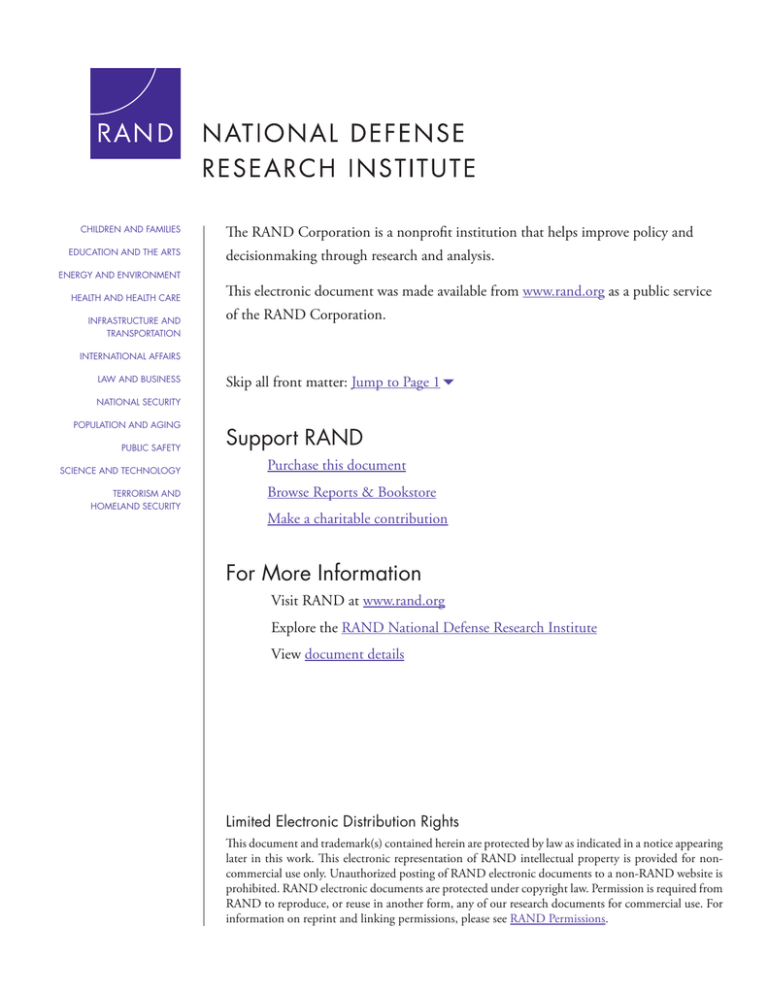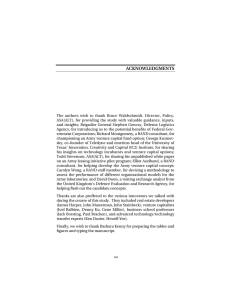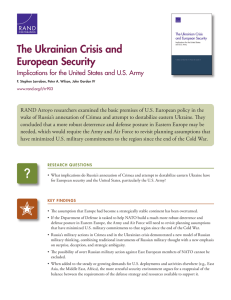The RAND Corporation is a nonprofit institution that helps improve... decisionmaking through research and analysis.
advertisement

CHILDREN AND FAMILIES EDUCATION AND THE ARTS The RAND Corporation is a nonprofit institution that helps improve policy and decisionmaking through research and analysis. ENERGY AND ENVIRONMENT HEALTH AND HEALTH CARE INFRASTRUCTURE AND TRANSPORTATION This electronic document was made available from www.rand.org as a public service of the RAND Corporation. INTERNATIONAL AFFAIRS LAW AND BUSINESS Skip all front matter: Jump to Page 16 NATIONAL SECURITY POPULATION AND AGING PUBLIC SAFETY SCIENCE AND TECHNOLOGY TERRORISM AND HOMELAND SECURITY Support RAND Purchase this document Browse Reports & Bookstore Make a charitable contribution For More Information Visit RAND at www.rand.org Explore the RAND National Defense Research Institute View document details Limited Electronic Distribution Rights This document and trademark(s) contained herein are protected by law as indicated in a notice appearing later in this work. This electronic representation of RAND intellectual property is provided for noncommercial use only. Unauthorized posting of RAND electronic documents to a non-RAND website is prohibited. RAND electronic documents are protected under copyright law. Permission is required from RAND to reproduce, or reuse in another form, any of our research documents for commercial use. For information on reprint and linking permissions, please see RAND Permissions. This product is part of the RAND Corporation technical report series. Reports may include research findings on a specific topic that is limited in scope; present discussions of the methodology employed in research; provide literature reviews, survey instruments, modeling exercises, guidelines for practitioners and research professionals, and supporting documentation; or deliver preliminary findings. All RAND reports undergo rigorous peer review to ensure that they meet high standards for research quality and objectivity. A Review of the Army’s Modular Force Structure Stuart E. Johnson, John E. Peters, Karin E. Kitchens, Aaron Martin, Jordan R. Fischbach Prepared for the Office of the Secretary of Defense Approved for public release; distribution unlimited NATIONAL DEFENSE RESEARCH INSTITUTE The research described in this report was prepared for the Office of the Secretary of Defense (OSD). The research was conducted within the RAND National Defense Research Institute, a federally funded research and development center sponsored by OSD, the Joint Staff, the Unified Combatant Commands, the Navy, the Marine Corps, the defense agencies, and the defense Intelligence Community under Contract W74V8H-06-C-0002. Library of Congress Control Number: 2011930376 ISBN: 978-0-8330-5130-1 The R AND Corporation is a nonprofit institution that helps improve policy and decisionmaking through research and analysis. RAND’s publications do not necessarily reflect the opinions of its research clients and sponsors. R® is a registered trademark. © Copyright 2012 RAND Corporation Permission is given to duplicate this document for personal use only, as long as it is unaltered and complete. Copies may not be duplicated for commercial purposes. Unauthorized posting of RAND documents to a non-RAND website is prohibited. RAND documents are protected under copyright law. For information on reprint and linking permissions, please visit the RAND permissions page (http://www.rand.org/publications/ permissions.html). Published 2012 by the RAND Corporation 1776 Main Street, P.O. Box 2138, Santa Monica, CA 90407-2138 1200 South Hayes Street, Arlington, VA 22202-5050 4570 Fifth Avenue, Suite 600, Pittsburgh, PA 15213-2665 RAND URL: http://www.rand.org To order RAND documents or to obtain additional information, contact Distribution Services: Telephone: (310) 451-7002; Fax: (310) 451-6915; Email: order@rand.org Summary Congress has taken great interest in the capabilities of the U.S. Army as the service has transitioned to its new, modular force structure. Congress recently requested an independent study to determine (A) The operational capability of the Army to execute the core mission of the Army to contribute land power to joint operations. (B) The ability to manage the flexibility and versatility of Army forces across the range of military operations. (C) The tactical, operational, and strategic risk associated with the heavy, medium, and light modular combat brigades and functional support and sustainment brigades. (D) The required and planned end strength of the Army.1 This study addressed these questions through comparative analysis, considering how the earlier, division-centric force structure compared to the current force structure. Many of the data to support the analysis were provided by the Army. In particular, the U.S. Army Training and Doctrine Command’s Army Capabilities Integration Center provided Army Structure Messages that allowed us to track changes in the Army’s force structure between 2003 and 2008, the period when much of the transition to the current modular force structure was taking place. The research team also made use of the Army’s Structure and Manpower Allocation System (SAMAS) database and FMSWeb for data on manpower and organizational characteristics of the force. We concluded that the present force structure is superior to the earlier force structure in terms of its ability to contribute land power to current and reasonably foreseeable joint operations, its flexibility and versatility across the range of military operations, and its associated risks. The analysis also demonstrated that the modular force structure produced a larger tactical force with a larger number of more aggregated capabilities than its predecessor force structure. Several insights from the analysis are worth special mention here. First, the Army’s longstanding practice of task organization (the process whereby senior commanders temporarily attach some of their units to subordinate commanders to execute a given mission) is not a symptom of flaws in the Army’s organizational design. Rather, it is a practice that allows a commander to tailor the force to the specific requirements of a given operation. For example, a commander might strip units from a subordinate commander who has a relatively easier 1 Public Law 111-84, National Defense Authorization Act for Fiscal Year 2010, October 28, 2009, Sec. 344. xi xii A Review of the Army’s Modular Force Structure task in the operation and assign them to another subordinate who faces more demanding tasks. Task organization is a practice that contributes to the Army’s flexibility and versatility, allowing it to adapt to changing circumstances. Second, larger headquarters at the BCT, division, and corps levels are not in themselves signs of bloat. They too contribute to the force’s flexibility and versatility because their size allows them to operate around the clock. They have more senior noncommissioned officers (NCOs) and field-grade officers than was the case in earlier headquarters designs, which enables better planning and wider spans of control (that is, the headquarters can effectively employ and control a larger number of subordinate maneuver units and integrate enabling organizations). Furthermore, senior NCOs and officers can be deployed to command company teams, battalion task forces, and other ad hoc organizations that allow the BCT, division, or corps to respond to unexpected challenges (or opportunities). Third, the current force structure has been developed for current operations. It is very different in design from the forces that the Army organized to oppose the Soviet Western Group of Forces, but that adversary no longer exists. The current force structure provides “overmatch” (overwhelming advantages) against today’s foes. Moreover, the process of adapting and adjusting the Army’s fielded forces continues. In this regard, the move to the current force structure should not be viewed as revolutionary; it really reflects long-standing Army practices of reacting to changed circumstances by updating its forces and their organization, doctrine, and equipment. Finally, concerns have been expressed regarding the absence of a third maneuver battalion in the heavy and infantry BCTs. The Army has been aware, almost from the beginning of the move to the brigade-centric force, of the limitations that the missing maneuver battalion imposes on the force, and it has crafted compensating tactics, techniques, and procedures. Former BCT commanders with whom we spoke would surely prefer a third maneuver battalion, but none believed that the two-battalion organization has led to greater risk in current operations. If circumstances changed and more capable adversaries appeared, the Army could reorganize to provide a smaller number of larger, three-battalion BCTs with the same end strength if it concluded that doing so would provide a clear advantage.






